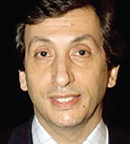
Michele Cavo, MD
Upfront autologous stem cell transplant remains the standard of care in patients with newly diagnosed multiple myeloma, even in the era of novel agents, according to a phase III study of the European Myeloma Network.1 “Our findings show that autologous stem cell transplant should remain the preferred treatment for patients with multiple myeloma aged 65 and younger,” said lead study author Michele Cavo, MD, at a press briefing in advance of the 2016 ASCO Annual Meeting, where the findings (abstract 8000) will be presented June 3, 2016. Dr. Cavo is Head of the Seràgnoli Institute of Hematology at the University of Bologna in Italy.
The randomized EMN02/HO95 MM trial is the largest study reported to date to compare autologous stem cell transplant with a bortezomib (Velcade)-based regimen alone in patients ≤ 65 years old. Although autologous stem cell transplant has long been the standard for young, fit patients with newly diagnosed disease, in the era of “novel agents,” the need for upfront autologous stem cell transplant has been debated, Dr. Cavo said.
“Over the past 10 years, therapies with novel mechanisms of action have dramatically increased response rates and have significantly extended survival in previously untreated patients,” he said. “The remarkable activity of novel therapies has led us to question the role of upfront autologous stem cell transplant.”
EMN02/HO95 Details
The trial enrolled 1,503 newly diagnosed patients ≤ 65 years old from multiple European centers. Following induction therapy with bortezomib/cyclosphosphamide/dexamethasone (VCD) and collection of peripheral blood stem cells, patients were randomly assigned to receive four cycles of bortezomib/melphalan/prednisone (VMP; n = 512) or high-dose melphalan (200 mg/m2; n = 754) followed by a single or double autologous stem cell transplant.
The study also evaluated the benefit of consolidation therapy, so a second randomization occurred to bortezomib/lenalidomide (Revlimid)/dexamethasone (VRD) or no consolidation. Both arms then received lenalidomide maintenance until disease progression or undue toxicity.
The primary endpoint was progression-free survival from the first randomization. A first prespecified interim analysis was performed in January 2016, when at least 33% of the required events had occurred. At that time, median follow-up was 23.9 months.
Transplant Favored in Interim Analysis
Median progression-free survival was not yet reached at the interim analysis; however, the analysis did show reductions in risk in the autologous stem cell transplant arm. Progression-free survival was significantly prolonged in patients randomized to receive high-dose melphalan plus autologous stem cell transplant—a benefit retained across several predefined patient subgroups (hazard ratio [HR] = 0.76; P = .010).
“Among patients who had not yet experienced disease progression, those randomized to upfront autologous stem cell transplant had a statistically significant 24% reduction in the risk of progressing at any future time point, compared to those randomized to chemotherapy alone, which included bortezomib but not auto-transplant,” Dr. Cavo reported.
Upfront Transplant vs Novel Agents in Multiple Myeloma
- The EMN02/HO95 MM trial is the largest study reported to date to compare autologous stem cell transplant with a bortezomib-based regimen alone in younger patients with multiple myeloma.
- At interim analysis, progression-free survival was significantly prolonged with high-dose melphalan plus autologous stem cell transplant.
- The benefit of transplant was even greater among high-risk patients.
Patients with advanced disease (International Staging System stage III) randomized to undergo autologous stem cell transplant had a 48% lower risk of disease progression, compared with drug treatment (P = .01), and patients with high-risk genetic factors [t(4;14) ± del(17p) ± del(1p) ± 1q gain] had a 28% lower risk (P = .03).
In comparison with patients who did not undergo autologous stem cell transplant, the transplant group had more high-quality responses (≥ very good partial response), 84.4% vs 74.0% (P < .0001), as well.
“The superior efficacy of high-dose chemotherapy and autologous stem cell transplant over chemotherapy alone is further supported by the significantly enhanced probability of achieving a high-quality response,” Dr. Cavo observed.
In a Cox regression analysis, randomization to autologous stem cell transplant was confirmed to be an independent predictor of prolonged progression-free survival (HR = 0.61; P = .001).
The overall survival data are not yet mature, but no differences between the groups have emerged. Additional prespecified study comparisons (consolidation therapy vs no consolidation, VMP vs either single or double autologous stem cell transplant, and single vs double autologous stem cell transplant) will be performed. ■
Disclosure: Dr. Cavo reported no potential conflicts of interest.
Reference



